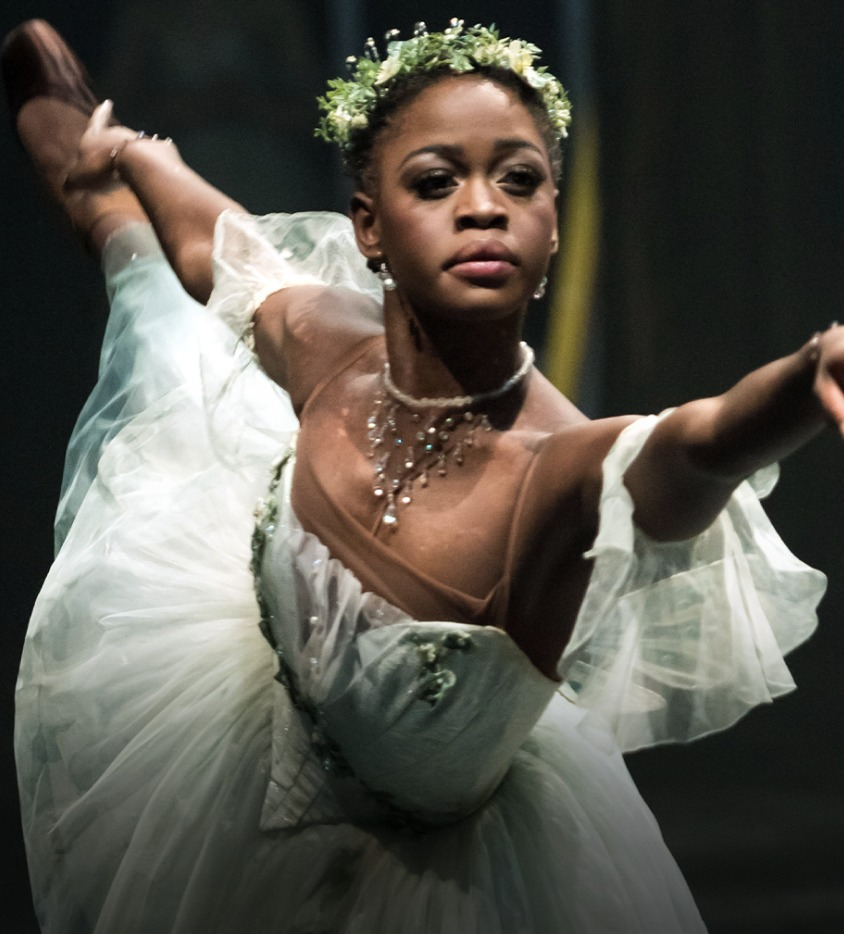
The ballet world is mourning the death of Dancing with the Stars’ Michaela Mabinty DePrince, an inspirational ballerina who beat staggering odds to become one of the world’s most famous dancers.
Michaela, an orphan from war-torn Sierra Leone, was a dancer with the Boston Ballet who gained widespread notoriety after starring in the 2011 documentary First Position. She died September 10 at only 29.
Adding to the family’s tragic loss, Michaela’s adoptive mom – who rescued Michaela from the filthy shelter where she was told she was “too ugly” to find a family – died only 24 hours later.
After her father was brutally killed in war-torn Sierra Leone and her mother died from fever, four-year-old Michaela Mabinty DePrince was abandoned by her uncle in a shelter where staff every day tried to break her spirit.
Known then as “Number 27” a young Michaela had little hope of finding a family as she had vitiligo, a condition that causes patches of skin to lose pigmentation.
The young girl, called “the devil child” because of her patchy skin, was told repeatedly that she was too ugly to be picked.
“We were all ranked from the most favored to the least, and I was at the very bottom for being rebellious and having a skin condition called vitiligo, which produces white freckles on my neck and chest,” Michaela said, adding she slept on a grass sleeping mat with “Number 26.”
Aside from the vomit-stained nightgown she was wearing, all she had was a magazine, which according to Glamour had (literally) blown onto her face. And on the cover was a ballerina en pointe – a dancer supporting all her body weight on the tips of her toes.
“The dancer looked beautiful and happy, that’s what caught my eye,” Michaela tells Glamour. “I wanted to be happy.”
And the crumpled old photo of the ballerina was the first thing she handed Elaine DePrince, who took her to her new home in New Jersey.
“There was so much love right away,” said Michaela, who over the next two decades would be the prima ballerina on the cover of magazines. “I had never been surrounded by something like that.”
‘My life is proof’
Michaela’s passion for dancing was ignited at a young age, and she pursued her dreams with remarkable dedication.
In 2011, Michaela became one of the stars of First Position, a documentary that followed six gifted dancers leading up to the competition for a place in the prestigious American Ballet Theatre’s Jacqueline Kennedy Onassis School of Ballet (JKO)
She not only earned a spot but was also awarded a scholarship to study at JKO.
The same year the award-winning documentary was released, Michaela also appeared on Dancing with the Stars.
“My life is proof that no matter what situation you’re in, as long as you have a supportive family, you can achieve anything,” Michaela said.
In 2012, the talented ballerina joined the renowned Dance Theatre of Harlem, where she continued to shine as a rising star. Her exceptional talent and grace later led her to the Dutch National Ballet, where the War Child Ambassador further established herself as a formidable presence in the ballet world.
While she was living in Amsterdam and training for The Nutcracker, she received a call, inviting her to travel to New Orleans and dance in Beyonce’s hour-long video, Lemonade, which was released in 2016.
Speaking with the Wall Street Journal of meeting the pop sensation, Michaela said, “She walked up to me and said, ‘It’s such an honor to have you here.’ I was really cheesy and said, ‘The honor is mine.’ I was on cloud nine.”
‘Beacon of hope’
On September 10, her family released a heartbreaking message about the principal soloist with the Boston Ballet.
“Rest in Power,” the post starts about the dancer who died on September 10. “With pain in our hearts, we share the loss of star ballerina Michaela Mabinty DePrince, whose artistry touched countless hearts and whose spirit inspired many, leaving an indelible mark on the world of ballet, and beyond.”
The Facebook post describes Michaela as an inspiration who “stood as a beacon of hope for many, showing that no matter the obstacles, beauty and greatness can rise from the darkest of places.”
The cause of her death has not yet been released.
Mom ‘spared the pain’
Only 24 hours after Michaela’s sudden death, her doting adoptive mom Elaine DePrince died on September 11 “during a routine procedure in preparation for a surgery.”
A family statement on Facebook explains that at the time of Elaine’s death, she was unaware that her daughter had died.
“As unbelievable as it may seem, the two deaths were completely unrelated. The only way we can make sense of the senseless is that Elaine, who had already lost three children many years ago, was by the grace of God spared the pain of experiencing the loss of a fourth child.” The message continues, “What the family is going through right now is truly unimaginably painful. Grieving two family members who died within a 24-hour period is tragic and devastating. We continue to ask for privacy…”
Rest in peace Michaela and Elaine. Please share your thoughts with us and then share this story so we can all send a lot of love to the family and friends of this mother-daughter duo.
It’s Bed Time And This Toddler Is Excited!

It is 7:30 PM, and Mia, who is three years old, is bursting with energy. Mia is excited for sleep, bouncing around the house with her favorite stuffed animal tucked under her arm and her jammies on.

Sarah and Mike, Mia’s parents, laugh as they observe the contrast between Mia’s eagerness for bedtime and their regular arguments. But Mia’s excitement is contagious tonight.
Giggling, Mia dashes to her room and calls out to her parents to join her for the ritual of going to bed. Mike and Sarah trail after, fascinated by Mia’s unexpected love of sleep.

The nightly routine takes a lively turn in Mia’s room. Mia insisted on selecting a colorful story about amiable dragons from a stack of books for her bedtime reading. To Mia’s enjoyment, Mike creates sound effects while Sarah reads aloud.
Following the narrative, Mia takes control of her nighttime routine, making sure to choose her coziest blanket, brush her teeth with a disproportionate amount of excitement, and arrange her stuffed animals in the ideal order.

Mia surprised Sarah and the rest of the family by breaking into her favorite bedtime song, complete with unexpected dance moves and off-key humming. When Sarah and Mike join in, the family starts singing happily.
After finishing her nightly rituals, Sarah bends in to kiss Mia good night. With beaming eyes, Mia whispers, “I love you, Daddy and Mommy,” and then curls up under her covers.
Mike and Sarah look at one other, amazed at the unanticipated happiness Mia has brought to their evening. They come to the realization that sometimes the cutest things may be the most heartwarming as they carefully exit Mia’s room.

Sarah and Mike, thankful for the small pleasures of bedtime and the love that unites their family, consider the beauty of parenthood as Mia smiles and goes to sleep. They feel fortunate to have such a lively and affectionate little daughter as they leave Mia’s room.



Leave a Reply